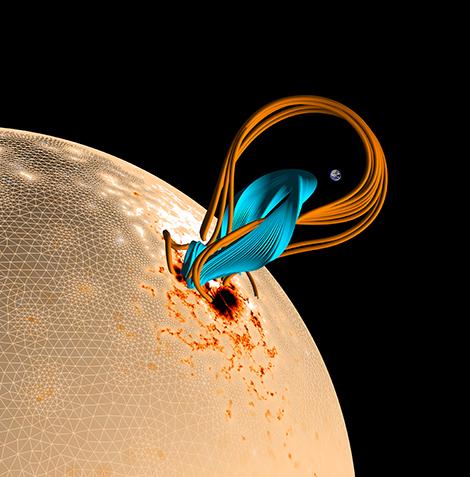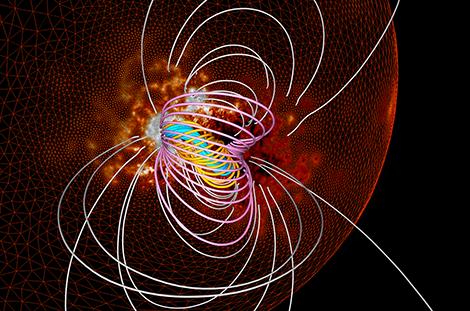Image: NASA Goddard
Earth orbits the Sun at a distance of 92 million miles, on average, which may seem like a fairly safe stretch. But when our star gets temperamental—and it frequently does—it blasts out enormous pulses of energy and radiation in the form of solar flares, which are often accompanied by eruptions of plasma called coronal mass ejections (CMEs).These events can be powerful enough to spark geomagnetic storms on Earth, which disrupt telecommunications, energy grids, and satellite constellations. As our civilization becomes more reliant on electronic infrastructure, the potential for harsh solar weather to wreak havoc will increase.That’s why Tahar Amari, a solar physicist at France’s École Polytechnique, is studying the mysterious events that lead up to solar flares and CMEs, so that we can better predict and prepare for them.Amari is lead author of a study published Wednesday in Nature, which zeroes in on a massive flare that occurred on October 24, 2014. His team assesses the event with a new method that explains why its energy output was so intense despite the fact that it was a so-called “confined flare,” meaning it didn’t produce a CME (flares that do produce CMEs are called “eruptive flares.”) As Amari and his team explain in the study, answering “basic questions” about the magnetic mechanisms that forecast a flare is “notoriously difficult.” This is because the behavior of Sun’s corona—its outer atmosphere, where flares are born—is much hotter than the Sun’s surface (for unknown reasons) and its magnetic properties are weaker and harder to measure than deeper layers of the star.To get around this challenge, Amari’s team examined the Sun’s surface, which lies about 1,300 miles below the edge of the corona. Here magnetic properties are stronger and easier to model, so the researchers used that data to build models that estimated processes at higher levels. They were especially interested in understanding the pre-flare movements of “twisted flux ropes,” which are magnetic tube-like structures that generate flares.By integrating this approach with observational data obtained from spacecraft like NASA’s Solar Dynamics Observatory (SDO) and the Geostationary Operational Environmental Satellite (GOES), the team reconstructed the behavior of the flux rope that powered the October 2014 event. They found that this particular structure was not strong enough to rip through its magnetic “cage,” as the Amari’s team calls it, which is why it did not produce a CME.
As Amari and his team explain in the study, answering “basic questions” about the magnetic mechanisms that forecast a flare is “notoriously difficult.” This is because the behavior of Sun’s corona—its outer atmosphere, where flares are born—is much hotter than the Sun’s surface (for unknown reasons) and its magnetic properties are weaker and harder to measure than deeper layers of the star.To get around this challenge, Amari’s team examined the Sun’s surface, which lies about 1,300 miles below the edge of the corona. Here magnetic properties are stronger and easier to model, so the researchers used that data to build models that estimated processes at higher levels. They were especially interested in understanding the pre-flare movements of “twisted flux ropes,” which are magnetic tube-like structures that generate flares.By integrating this approach with observational data obtained from spacecraft like NASA’s Solar Dynamics Observatory (SDO) and the Geostationary Operational Environmental Satellite (GOES), the team reconstructed the behavior of the flux rope that powered the October 2014 event. They found that this particular structure was not strong enough to rip through its magnetic “cage,” as the Amari’s team calls it, which is why it did not produce a CME. However, it was unstable enough to degrade the integrity of the cage, which resulted in powerful X-ray emissions breaking through in localized spots, generating the epic flare captured by SDO.By decoding this mysterious process, Amari and his team have pioneered a new method of predicting the maximum amount of energy that can be emitted from flares and CMEs. This is crucial information in terms of preparing for future space weather events, and the damage they might inflict on infrastructure. Amari hopes to create even better predictions as next-generation missions—like the Parker Solar Probe, due for launch this year—observe the Sun from never-before-achieved distances and angles.
However, it was unstable enough to degrade the integrity of the cage, which resulted in powerful X-ray emissions breaking through in localized spots, generating the epic flare captured by SDO.By decoding this mysterious process, Amari and his team have pioneered a new method of predicting the maximum amount of energy that can be emitted from flares and CMEs. This is crucial information in terms of preparing for future space weather events, and the damage they might inflict on infrastructure. Amari hopes to create even better predictions as next-generation missions—like the Parker Solar Probe, due for launch this year—observe the Sun from never-before-achieved distances and angles.
Advertisement

Advertisement

It “all starts with data,” Amari told me over email. “NASA missions such as SDO, that we used for this discovery, are great, but the [upcoming] Parker Solar Probe will be too, and the great European Solar Orbiter mission will be very useful.”In other words, it would be helpful to launch missions that observe the Sun from multiple angles, not just whatever side of it Earth happens to be on, so that we can anticipate disturbances that aren’t visible from our planet. Amari also told me it’s important that we understand the behavior of energy ejected by the Sun as it travels to Earth, a goal the Obama White House prioritized in 2015 with the National Space Weather Strategy initiative.He is hopeful that these efforts will lead to a system for monitoring and evaluating space weather risks, so that their impact can be managed. “I am not alone,” Amari noted. “There is a fantastic community of scientists over the world who work hard on all those problems too and contribute to our understanding and, at the same time, to make predictions better.”Get six of our favorite Motherboard stories every day by signing up for our newsletter.Read More: How to Prepare a Spacecraft to Fly Through the Sun’s Atmosphere
